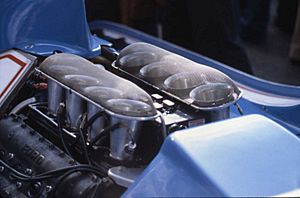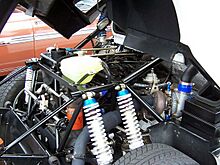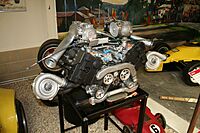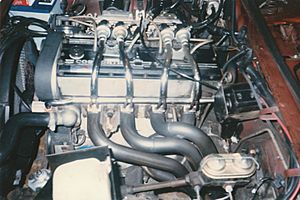Cosworth facts for kids
| Private | |
| Industry | Automotive, automobile racing (motorsport) |
| Founded | 1958 London, England, U.K. |
| Founders | Mike Costin Keith Duckworth |
| Headquarters | Northampton, England |
|
Area served
|
Worldwide |
|
Key people
|
Hal Reisiger (CEO) |
| Products | Internal combustion engines, electronic data acquisition, and control systems |
| Services | High performance engineering, precision manufacturing |
| Owners | CGH (Isle of Man) Holdings Ltd & Indeck-Cosworth LLC |
| Parent | United Engineering Industries (1980–1990) Vickers plc (1990–1998) Ford (1998–2004) |
| Formula One World Championship career | |
|---|---|
| First entry | 1967 Monaco Grand Prix |
| Last entry | 2013 Brazilian Grand Prix |
| Races entered | 681 |
| Constructors' Championships | 10 |
| Drivers' Championships |
13 |
| Race victories | 176 |
| Podiums | 535 |
| Points | 4463.50 |
| Pole positions | 140 |
| Fastest laps | 161 |

Cosworth is a British company that makes special parts for cars. It was started in London in 1958. They are known for making powerful internal combustion engines, which are the parts that make cars move. They also make electronic systems for car racing and regular cars. Cosworth is based in Northampton, England. They also have offices in other parts of England and in Indianapolis, USA.
Cosworth has won 176 races in Formula One (F1) by supplying engines to racing teams. This makes them the third most successful engine supplier in F1 history, after Ferrari and Mercedes.
Contents
Cosworth's Story
Cosworth was started in 1958 by two friends, Mike Costin and Keith Duckworth. The name "Cosworth" comes from combining parts of their last names. Both founders used to work for a famous car company called Lotus. Because of this, Cosworth first worked mostly with Lotus.
Keith Duckworth left Lotus to start Cosworth. Mike Costin stayed at Lotus for a while, working on Cosworth projects in his free time. Early on, Cosworth made engines mainly for Lotus cars. But soon, their engines for Formula Junior races became very popular. This helped Cosworth earn money from other teams too. It allowed them to focus more on developing racing engines.
In 1966, Cosworth created a new engine called the FVA. It had a special design with two camshafts and four valves per cylinder. This design was very advanced. With help from Lotus founder Colin Chapman, Cosworth convinced Ford to buy the rights to this design. Ford also agreed to help develop an eight-cylinder version of the engine. This led to the creation of the famous DFV engine, which became a legend in Formula One.
For many years, Ford supported Cosworth. Many of Cosworth's engine designs were owned by Ford and named after Ford.
Over time, Cosworth changed owners several times. In 1980, Keith Duckworth sold the company to United Engineering Industries (UEI). Later, in 1990, another engineering company called Vickers plc bought Cosworth.
In 1998, Vickers sold Cosworth to Audi. Audi kept some parts of the company, which they called Cosworth Technology. They sold the racing engine part, Cosworth Racing, and its electronics division, Pi Research, to Ford. In 2004, Ford then sold Cosworth Racing and Pi Research to two owners of the Champ Car World Series, Gerald Forsythe and Kevin Kalkhoven. This created the Cosworth Group we know today.
Since 2006, Cosworth has started working on other projects. They now offer engineering advice, high-performance electronics, and parts manufacturing for areas outside of car racing. For example, in 2008, the United States Navy hired Cosworth to develop a special engine for their drones.
Cosworth also partnered with Aston Martin to create a very powerful engine for the Aston Martin Valkyrie road car. This engine is a 6.5-litre V12 engine that produces 1,000 horsepower!
Cosworth supplied its last engines to a Formula One team in 2013. That team was the Marussia F1 Team.
Famous Engines
Cosworth is famous for its powerful and innovative engines. Here are some of their most well-known designs:
The SCA and FVA Series
In 1964, Cosworth introduced the SCA engine. It was a 997 cc engine designed for Formula Two racing. This engine was special because it had the first cylinder head completely designed by Cosworth. It was a single overhead camshaft (SOHC) engine. The SCA was quite successful, especially when it got fuel injection in 1966, reaching 140 horsepower.
The FVA (meaning "Four Valve Type A") was introduced in 1966 for Formula 2. This engine was a big step forward. It had 16 valves and two overhead camshafts. It produced about 225 horsepower at 9000 rpm. The FVA engine was very dominant in its racing category until 1971. Many of the ideas from the FVA were later used in the legendary DFV engine.
The DFV (Double Four Valve)
The DFV engine is perhaps Cosworth's most famous creation. In 1966, Colin Chapman from Team Lotus convinced Ford to pay for Keith Duckworth to design a new 3000 cc Formula One engine. Cosworth received £100,000 for this project. The DFV stands for "Double Four Valve" because it had four valves per cylinder.
The DFV engine was a huge success. It won its very first race in 1967 with Jim Clark driving a Lotus 49. From 1968, any F1 team could buy this engine. During the 1970s, almost every F1 team used a Cosworth DFV engine. It won a record 155 World Championship races. Its last win was in 1983.
Even though the DFV (3.0 litres, 410 horsepower) wasn't always the most powerful engine, it was lighter than its rivals. This gave cars using it a better power-to-weight ratio. Also, it was designed to be a strong part of the car's structure, which was a clever idea used by Colin Chapman.
Later versions of the DFV, like the DFY (1982), were made to be more powerful. But they still struggled against the new turbocharged engines in F1. After 1986, the DFV was used in lower racing series like International Formula 3000.
DFV Variants
The DFV engine led to many other successful engines.
- The DFX (1975) was a turbocharged version made for IndyCar racing in the US. It became the standard engine for IndyCar for many years.
- The DFL was developed for endurance racing in 1982. It came in different sizes and was very popular in the C2 Class of Group C racing.
The BDA Series
In 1969, Cosworth worked with Ford again to develop the BDA engine. This was a 16-valve, four-cylinder engine for road cars like the Ford Escort. BDA stands for "Belt Drive, A type" because it used a special toothed belt to drive the camshafts. It was used in rallying and touring car racing.
The BDA series was very successful. Different versions were made, including the BDG (1973), which had an aluminium engine block. The BDA and its variants won many championships around the world in different racing categories.
A turbocharged version, the BDT, was created in 1981. It powered the Ford RS200 rally car, which was built for Group B rallying. A more powerful version, the BDT-E, could produce over 600 horsepower!
The GA/GAA V6
In the early 1970s, Ford asked Cosworth to develop a powerful V6 engine for their Ford Capri race cars. This engine was called the GA or GAA. It was based on a Ford V6 engine but had new cylinder heads with four valves per cylinder and fuel injection.
The GA engine produced around 462 horsepower. It was very competitive against other race cars in the European Touring Car Championship. Ford also sold some of these engines to other racing teams, and they were used in Formula 5000 races. These engines are now very rare and expensive.
The FBA and FBC V6
The FBA and FBC engines were V6 engines found in Ford road cars like the Ford Granada and Ford Scorpio. The FBA, also known as the 'BOA', was a 24-valve version of a Ford V6, making it more powerful (195 horsepower).
In 1995, the FBC (known as the 'BOB') was released with even more power (204 horsepower). These engines were usually paired with automatic gearboxes in road cars. However, car enthusiasts often modified them, sometimes adding turbos to reach around 400 horsepower.
The YB Series
The YB series of 2.0-litre engines were used in high-performance Ford road cars like the Ford Sierra RS Cosworth (1986). These cars were built for racing in Group A rallies and touring car races. The road version had 204 horsepower.
The racing versions of the Sierra RS Cosworth were very powerful, reaching around 370 horsepower. A special edition, the Sierra RS500, had an even bigger turbo and could produce up to 550 horsepower in racing trim.
The RS500 dominated touring car racing from 1987 to 1992, winning many championships and major races around the world. By the end of its racing life, some YB engines in Australia were making around 600 horsepower!
The YB engine was also used in the Ford Escort RS Cosworth. Production of cars with the YB engine stopped in 1997.
The GBA V6 (Formula One Turbo)
Cosworth also designed a turbocharged 1.5-litre V6 engine for Formula One, called the GBA (or Ford TEC). This engine was designed by Keith Duckworth and Geoff Goddard. It raced in F1 in 1986 and 1987 with the Haas Lola and Benetton teams.
The GBA engine was Cosworth's most powerful F1 engine, producing about 900 horsepower. It was the first Cosworth engine to use a turbocharger in F1.
The HB V8
The HB V8 engine was designed to replace the DFV series in Formula One. It was a 3.5-litre V8 engine introduced in 1989 with the Benetton team. It had a narrower V-angle (75°) compared to the DFV.
The HB engine was initially rated at about 630 horsepower. By 1993, it was producing around 700 horsepower at 13,000 rpm. Although it was less powerful than some V10 and V12 engines from rivals, it was lighter and used less fuel. In 1993, McLaren used a customer version of the HB engine and won five Grand Prix races with Ayrton Senna.
The EC, ECA, ED, EDM and ED 2/4 V8
The HB engine was further developed into the EC V8 for the 1994 F1 season. This engine, called Ford Zetec-R, produced about 740 horsepower. Michael Schumacher won his first Formula One World Championship with this engine in a Benetton car in 1994. This was the last F1 title won with a Ford-powered engine.
For the 1995 season, F1 engine rules changed to 3.0 litres. The EC was modified into the ECA, which produced about 610-630 horsepower. Other teams used customer versions of the engine, called ED, EDB, EDC, EDD, and EDM.
The JD, VJ and VJM V10
To get even more power, Cosworth designed a completely new 3.0-litre V10 engine called the JD for 1996. It produced about 670 horsepower at 15,800 rpm. This engine was also called Ford Zetec-R. It was later developed into the VJ and VJM versions, reaching 720-730 horsepower at 16,500 rpm.
Other F1 Engines
Cosworth continued to supply engines to F1 teams like Stewart Grand Prix (which became Jaguar Racing) and Minardi. Their CR-1 engine (1999) eventually reached 770 horsepower.
In 2006, Cosworth returned to F1 with the CA2006 2.4-litre V8 engine, which produced about 755 horsepower. This engine was used by Williams.
After a few years away, Cosworth came back to F1 in 2010 as an engine supplier for several teams, including Williams, Hispania Racing, Lotus Racing, and Virgin Racing. The CA2010 engine was a re-tuned version of the CA2006, adjusted for the new F1 rules.
Other IndyCar and Champ Car Engines
Cosworth also designed a series of engines for IndyCar and Champ Car racing, known as the X-series. The XB was introduced in 1992. The XF was chosen as the standard engine for the Champ Car World Series in 2003. The latest version, the XFE, was a 2.65-litre V8 engine that produced around 750-800 horsepower.
These engines were very successful in American open-wheel racing for many years.
Other Road Engines
Cosworth is well-known in Europe for its work with Ford on high-performance cars like the Ford Sierra RS Cosworth and Ford Escort RS Cosworth. They also helped create other Ford models like the Escort RS1600 and RS200.
In the US, Cosworth also worked on the Chevrolet Vega in the 1970s. Only 3,508 of these cars were made. The engine had a special cylinder head designed with Cosworth's help.
Cosworth has also worked with other car companies like Opel (on rally cars like the Opel Ascona 400) and Mercedes-Benz (on the 190 E 2.3-16 sports sedan). For Mercedes-Benz, Cosworth designed a powerful 16-valve engine, which was later used in DTM racing.
More recently, in 2020, Cosworth designed and built a 3.99-litre V12 engine for the new Gordon Murray T.50 sports car. This engine produces 663 horsepower and can rev up to an amazing 11,500 rpm!
Cosworth F1 Car
In 1969, Cosworth even tried to design its own Formula One race car. The car was designed by Robin Herd and had a special 4WD system designed by Keith Duckworth. It was powered by a lightweight version of the DFV engine. However, the project was stopped before the car ever raced.
Formula One World Championship Results Summary
Cosworth has a long and successful history in Formula One.
- They debuted in 1967 and supplied engines until 2013.
- Cosworth engines won 10 Constructors' Championships and 13 Drivers' Championships.
- They achieved an incredible 176 Grand Prix wins.
- Their most dominant period was in the 1970s, especially with the DFV engine, which powered many championship-winning teams and drivers.
- Notable wins include Jim Clark's first win with the DFV in 1967, Jackie Stewart's championships with Tyrrell, and Michael Schumacher's first championship with Benetton in 1994.
See also
 In Spanish: Cosworth para niños
In Spanish: Cosworth para niños
- Marcos Engineering
- MAHLE Powertrain













